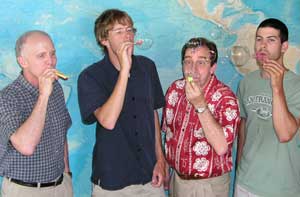 |
| Bernard Boudreau, Bruce Johnson and PhD students Chris Algar and Mark Barry explore the lighter side of their research project. |
We´ve all seen bubbles in liquids, like soap bubbles or the fizz in pop. But you might not have known that bubbles can also form in solids. Until recently, very little was known about what these bubbles in solids looked like, how they grew, or how they moved.
Bernard Boudreau and Bruce Johnson of the Department of Oceanography, working with several researchers in the U.S., have now shown that bubbles in solid look nothing like the round ones in liquid, and it took almost six years to figure it out.
Boudreau and Johnson have been on a quest to find out just how bubbles work in soft solids, like the mud in marshes or the ocean floor. They've found that these bubbles are nearly flat, looking something like a corn flake. They've also discovered that these bubbles move by fracturing their way through the solids.
But why did it take six years? At first, Boudreau and Johnson simply couldn't find the bubbles. "We started by injecting bubbles into mud, and then freezing it," explains Boudreau.
"But," Johnson adds, "no matter how we sectioned the mud, we just couldn't find any bubbles." It took many sleepless nights and lots of trial and error in the lab before the pair came up with a "high-tech" solution: Ordinary, store-bought gelatine.
It turns out that gelatine replicates the properties of mud very closely. "If you wanted, you could buy some Jell-O at the store and do this at home," Boudreau says.
Blowing bubbles into a clear medium, it became obvious that the bubbles weren't missing, but were in fact so flat that you could hardly see them in mud. And, they leave no trail in the mud; once the bubble has moved, the fracture closes behind it.
Equipped with this new knowledge, they can now image bubbles injected into actual mud. Two oceanography PhD students, Chris Algar and Mark Barry, travel regularly to a facility in Mississippi to image these samples using an industrial CAT scanner.
So the next obvious question: why do we need to know what bubbles in mud look like?
There are actually several very meaningful applications for this research. Boudreau and Johnson's work was supported in part by the U.S. Navy, to help improve acoustic imaging. Bubbles in the sea floor create acoustic "dead zones" in which you simply can't tell what's down there. It's a particularly dangerous problem if you're searching for mines or sunken ships. And, if you're building an oil rig or bridge, you want to be sure that bubbles won't rise and destabilize your foundation.
Also, a great deal of natural methane, a strong greenhouse gas, is released into the atmosphere from bubbles in mucky wetlands. If you don't know what shape the bubbles are, and how fast they grow and rise, it´s hard to predict how much methane is entering the environment and contributing to climate change.
This finding has also given benthic biologists a new model to describe how worms, clams and other creatures move through muddy solids. And, according to Boudreau, it may also help you bake a better loaf of bread. "If you look, the small bubbles in bread are round, while the larger ones are more oval-shaped. Bread might just be another soft solid we can apply this to," he says.
The next step for these researchers will be to refine the quantitative theory that describes this process of bubble growth and rise. And after six years, it might be time for this pair of researchers to celebrate this discovery with a glass of "bubbly!"
